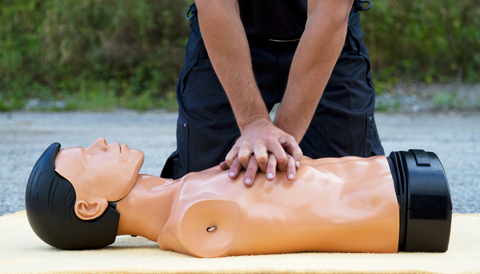
How to Perform Chest Compressions: Step-by-Step
1. Kneel beside the person with both of your knees close to the person’s chest. Lean over the chest.
2. Place your hands on top of each other and position the base of your bottom hand over the middle part of the breastbone. Position your elbows and shoulders directly over your hands.
3. Use your weight to compress the chest, leaning your entire body weight down on your arms to apply pressure. Do not bend your elbows (like they do on TV). Compress the chest down at least 2 inches (5cm; yes, that’s also a lot more than they do on TV).
4. Compress at a minimum rate of 100 times per minute. The rate is the same as the beat of the Bee Gees’ tune, Stayin’ Alive.
5. Compress until help arrives. If you’re using an AED, it will direct you when to compress and when to stop.
6. If you don’t have an AED, stop and quickly recheck for a pulse or other signs of life such as breathing or responsiveness every two minutes. If someone is with you, take turns performing compressions.
7. If no help comes and you don’t get a pulse or other sign of life, there will come a time when continuing is fruitless. Stop if you become exhausted. It’s extremely rare to revive a person unless you have an AED or can transfer her to a medical facility. Even then, it’s pretty uncommon, so don’t be too hard on yourself if you’ve done your best.
Why Chest Compressions? Why Not CPR?
Current thinking is that artificial respirations, such as those used in CPR (cardiopulmonary resuscitation), aren’t effective when performed by non-medical personnel.
The treatment does little to improve the overall recovery of someone whose heart has stopped beating.
It’s more useful and efficient for a nonmedical person to spend her time on proper chest compressions.
Recommendations do change from time to time depending on new data. The best way to keep up with the latest recommendations, and also to learn how to properly perform CPR, is to take a hands-on course.
Call your local hospital, the American Red Cross or your local chapter of the American Heart Association to enroll.







